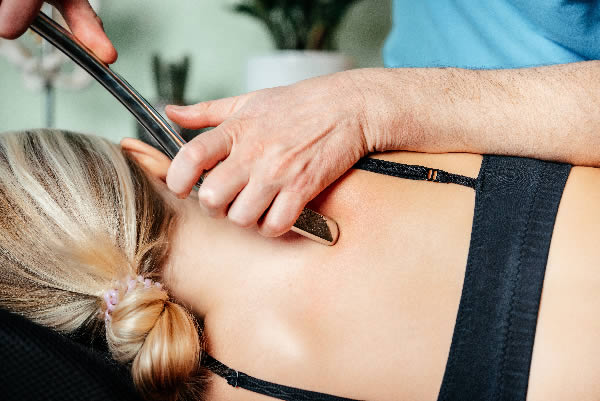
What is Graston Technique?
Graston Technique is a type of manual therapy that uses stainless steel instruments to treat dysfunction and pain in connective tissue. It is form of Instrument Assisted Soft Tissue Manipulation. While the instruments may look a bit medieval, treatments should not cause extreme pain. The tools are made of stainless steel and are either concave or convex-shaped. They have rounded edges that are not sharp but can be more precise compared to a therapist’s hands. These design elements assist in diagnosing the location and isolating the treatment of a connective tissue lesion. Graston Technique is well researched and has been proven to improve tissue quality while decreasing healing time.
How it works
A therapist first uses a Graston instrument to assess tissue quality in order to identify abnormalities and pain. Very specific techniques are then used to release and break up muscular adhesions, fascial restrictions and scar tissue, all of which can limit movement or cause pain. The instruments have unique edges and angles that help amplify the abnormal texture of the tissue. Think of them as an extension of your therapist’s hands but more precise. Treatments will end with the affected areas stretched and then exercises of high repetition and low load performed. In essence, the instruments and stretching are used to extrinsically affect the physiology of the tissue and then exercises are utilized to intrinsically tell the remodeled tissue what to do.
Benefits of The Graston Technique
- Accelerated recovery time
- Decreased duration of treatment time
- Decreased pain and inflammation
Clinical Indications
- Tendonopathy
- Lateral and medial epicondylosis
- Supraspinatous tendonosis
- Achilles tendonopathy
- Patellar tendonopathy
- De Quervains Tenosynovitis
- Fascial Syndromes
- Plantar fasciitis
- ITB syndrome
- Trigger finger
- Ligamentous Injuries
- Scar Tissue Adhesions
- Myofascial Lesions Associated with Other Diagnosis
- Ex. Muscular pain associated with endometriosis
- Entrapment syndromes
- Myofascial pain syndrome
- Trigger points
- Fibromyalgia
Why it works
Graston Technique is a very specific type of Soft Tissue Manipulation, which is defined as the forceful, passive movement of connective tissue through its restrictive directions beginning with its most superficial layers and progressing into depth while taking into account its relationship to the joints concerned (Grodin & Cantu). Graston Technique often utilizes Cross Friction Massage, which is a type of Soft Tissue Manipulation that involves applying pressure and friction in a direction perpendicular to the tissue being treated. This causes micro trauma to the tissue increasing blood flow and fibroblast activity. Fibroblasts are cells that create and maintain the connective tissue. More fibroblasts equals more healing.
As its name implies, “connective tissue” refers to body tissues that connect, support, and help bind other tissues; basically holding everything together. It includes fascia, ligaments and tendons, to name but a few. While muscles are not considered connective tissue, their cells and fibers are bound together by it. Every single cell, from muscle to nerve and from bone to skin is surrounded by some kind of connective tissue. It contributes to numerous body functions, including supporting organs and cells, transporting nutrients and wastes, defending against pathogens, storing fat, and repairing damaged tissues. It is composed of cells (like macrophages and fibroblasts), fibers (collagen, elastin), and a gel-like ground substance. Connective tissue exists between every muscle cell, fiber, and fascicle in the body.
When connective tissue is injured, the fibers become closer together and stuck, limiting movement and impairing sensation. Macrophages start working more than fibroblasts. Macrophages are the cells that recognize and destroy damaged cells versus fibroblasts, which contribute to the formation of new connective tissue. If allowed to heal without treatment, an irregular pattern of scar and fibrotic tissue will develop. This change in connective tissue can be felt and treated with a Graston instrument. Graston Technique produces a mechanical stimulus to connective tissue that when sensed by the cell surface creates a biochemical reaction. This reaction directs cellular activity influencing growth, remodeling, and repair with ultimate outcomes being altered tissue mass, structure and quality. So Graston Technique is not necessarily breaking down scar tissue but using theses properties to affect connective tissue quality. The change in physiologic processes that Graston Technique elicits are what are important to decreasing pain and dysfunction.
Schedule an appointment at Femina Atlanta today and see what the Graston Technique can do for you!
References:
Cantu, Robert, Grodin, Alan J., Stanborough, Robert W. Myofascial manipulation: Theory and Clinical Application, 3rd ed.
Gregory D. Cramer, Barclay W. Bakkum, in Clinical Anatomy of the Spine, Spinal Cord, and Ans (Third Edition), 2014
Geoffrey Marston; Tafline C. Arbor; Arif Jan. Anatomy, Connective Tissue Payvand Kamrani;
Gregory D. Cramer and Barclay W. Bakkum. Microscopic Anatomy of the Zygapophysial Joints, Intervertebral Discs, and Other Major Tissues of the Back
